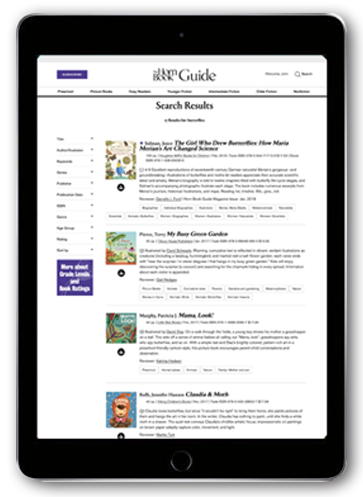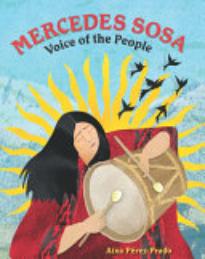Lee/Children's
20 Reviews
(3)
K-3
This picture-book biography tells the story of Mercedes Sosa, popular folklore Argentino singer and activist. Pérez-Prado uses accessible, lyrical prose and includes difficult details about Sosa’s life and the time period during which she performed, including her years of exile in Spain and a brief, age-appropriate history of los desaparecidos. Digital collage illustrations incorporate visual metaphors to emphasize Sosa’s culture, including her Indigenous roots. An afterword providing further historical context and bibliography are appended.
Reviewer: Monica de los Reyes
(3)
PS
Mia and her uncle Eddie walk through their Chinatown neighborhood to the Big Wok for dim sum. On the way--ten blocks in all--they encounter one giant panda, two stone lions, and so on, up to ten red lanterns. As Mia enjoys dim sum, she counts in reverse ("...nine fried wontons, eight shumai, seven tofu-skin rolls..."). The text is printed in both English and Chinese and ends with notes about each object's significance in Chinese culture. Hu's bright, cheerful digital illustrations of a child whose smile never wavers invite the reader to notice and enjoy the many special elements of Mia's neighborhood. A guide to the numbers one to ten in Chinese and sources are appended.
Reviewer: Maeve Visser Knoth
(2)
K-3
Translated by Luis Humberto Crosthwaite.
Illustrated by
Magdalena Mora.
This book's bilingual text tells the story of a young child and his parents as they leave the United States for Mexico during the repatriation process in the 1930s--an overlooked part of U.S. history. The child's family--mother and son were born in the United States; Papá was born in Mexico--harvests pecans in Texas until new immigration policies and the threat of deportation force them to move to Mexico to keep their family together. Martínez's straightforward prose centers the boy's feelings of sadness, uncertainty, and hope as he leaves his home behind for a place he and Mamá only know about from Papá's stories. The cool colors of Mora's dreamlike gouache, ink, and digital illustrations offer reassurance as the family drives toward their future. An appended author's note details a difficult history of forced migration shared by many, while the story emphasizes the importance of family and ultimately feels optimistic. Butterflies--a contemporary symbol of the immigrants' rights movement--are included on most pages. This motif and the author's note contextualize the historically set narrative within the continued struggle for immigrants' rights.
Reviewer: Monica de los Reyes
| Horn Book Magazine Issue:
November, 2022
 Newman, Lesléa
Newman, Lesléa
Alicia and the Hurricane / Alicia y el huracán: A Story of Puerto Rico / Un cuento de Puerto Rico
(2)
K-3
Translated by Georgina Lázaro.
Illustrated by
Elizabeth Erazo Baez.
Newman wrote this book in the aftermath of 2017's Hurricane María in Puerto Rico, and people's subsequent worry about whether the tiny tree frogs, or coquíes, a cultural symbol of Puerto Rico, would return. Every night, Alicia's mami tells her, "Hop into bed like a little frog, mi corazón, and los coquíes will sing you to sleep." But then a hurricane strikes, and while Alicia and her family are staying in a shelter, she can no longer hear the frogs' song. After the storm passes, her community comes together to rebuild her devastated neighborhood, but it is only on the last page that Alicia is sure that the coquíes have returned, too. Baez's detailed acrylic on canvas illustrations aptly convey Alicia's emotional journey as well as the bright, tropical colors of Puerto Rico. The layout of this bilingual book foregrounds the Spanish translation by Lázaro, a Puerto Rican children's author and poet in her own right, and the English text includes Spanish words readers can understand from context, as cognates, or using the book's glossary. An author's note includes detailed information about tree frogs, Puerto Rican identity, hurricanes, and hurricane relief efforts.
(1)
K-3
Translated by Adriana Domínguez.
Illustrated by
Elisa Chavarri.
This picture-book biography of Peruvian archaeologist and educator Julio C. Tello (1880–1947) forefronts Indigenous Peruvian science, knowledge systems, and art. Brown centers Tello's indigeneity from the opening spread. Born in 1880 "in the shadow of the Andes mountains," Tello spoke Quechua, the language spoken across generations of Indigenous Peruvian people. Nicknamed Sharuko for his brave disposition ("not even the skulls he and his brothers uncovered in ancient tombs" scared him), twelve-year-old Tello left the highlands for Lima to commence his studies, initiating a prolific and multi-continent educational journey. He returned to Peru in 1913, where at the Museum of Natural History in Lima he conducted groundbreaking excavation and fieldwork investigating the daily life of ancient Peruvians. Brown's text, usually appearing in Spanish on the left-hand pages and in English on the right (expertly translated by Domínguez), is informative and engaging. Chavarri's gouache and watercolor illustrations show panoramic Andean vistas, with saturated yellows balancing muted green hues; vignettes focus on resplendent brown faces; details in the art invite visual inquiry into renderings of colorful Paracas textiles and sculpted cabezas clavas from the archaeological site Chavín de Huántar. Author and illustrator notes affirm Brown's and Chavarri's (both of Peruvian descent) commitment to perpetuating Peru's Indigenous culture. A bibliography is appended.
Reviewer: Lettycia Terrones
| Horn Book Magazine Issue:
July, 2020
(2)
4-6
In the 1930s, the Mexican American community in Lemon Grove, California, organized to bring a lawsuit against the school board--"the first successful school desegregation case"--after the board secretly commissioned building an inferior school to segregate Mexican American children. The third-person text, in both Spanish and English, is told from the perspective of twelve-year-old Roberto. Hale skillfully uses such visual techniques as large halo shapes and split panels to depict the unfolding events while also highlighting aspects of everyday life in this small agricultural town. Bib.
Reviewer: Lettycia Terrones
| Horn Book Magazine Issue:
November, 2019
(2)
K-3
Illustrated by
Jorge Lacera.
Young zombie Mo Romero has an "absolutely despicable" craving for vegetables, but his parents prefer such delicacies as "brain-and-bean" tortillas. And disguising gazpacho as "blood bile bisque" doesn't win his parents over...at least not at first. This Halloween take on a be-yourself story--with occasional, naturally integrated Spanish--is full of wordplay both in the text ("Holy aioli!") and in the muted digital illustrations. Also available in Spanish.
Reviewer: Shoshana Flax
| Horn Book Magazine Issue:
September, 2019
(2)
K-3
Illustrated by
Beatriz Vidal.
This is a lightly fictionalized picture-book biography of Mexican author Sor (Sister) Juana Inés de la Cruz (1648–1695), then keeper of one of the largest libraries in the Americas. Watercolor and gouache illustrations lend a sunny, idyllic feel to Juana's Mexico. As the original Horn Book review noted, there's no formal bibliography, but Mora acknowledges the work of "the Sor Juanistas, scholars of Sor Juana." Appended with an author's note and glossary for interspersed Spanish words. Concurrently published with a new edition in Spanish: Una biblioteca para Juana.
Reviewer: Shoshana Flax
| Horn Book Magazine Issue:
November, 2002;
November, 2019
(2)
K-3
Translated by Adriana Domínguez.
Illustrated by
Angela Dominguez.
This bilingual picture-book biography chronicles the early life of biologist Valentina Cruz, born in 1971 on Floreana, a Galápagos island. Readers accompany Cruz on an introductory tour of Floreana and its animals that she vows to protect, brought to vivid life through Dominguez's vibrant, digitally-colored pencil illustrations. Translation of the English text into Spanish (including the appended author's note and animal descriptions) is concise and accurate. Bib.
Reviewer: Monica Tapia Boyer
| Horn Book Magazine Issue:
November, 2018
 Alarcón, Francisco X.
Alarcón, Francisco X.
Family Poems for Every Day of the Week / Poemas familiares para cada día de la semana
(2)
K-3
Illustrated by
Maya Christina Gonzalez.
Alarcón uses simple, richly descriptive verse (printed in Spanish and English) to explain the origins of the days of the week while celebrating a Latino family's traditions. Gonzalez's full-bleed double-page-spread illustrations, in watercolor, gouache, and acrylic marker, pay tribute to "Mexico's indigenous crafts." An illustrator's note reveals Alarcón died in 2016 but adds that his unique way of portraying the Latino experience through poetry will live on. Bib.
Reviewer: Alma Ramos-McDermott
| Horn Book Magazine Issue:
January, 2018
(3)
K-3
Dive into Reading series.
In three entertaining stories, tree frog siblings Rafi and Rosi explore Puerto Rico's El Morro fort by playing pirates, finding gold doubloons, and discovering a haunted sentry box. This third series entry again sprinkles Spanish words throughout a slightly advanced text supported by soft watercolor and colored-pencil illustrations. Extensive back matter provides historical information about topics mentioned in the stories. Also available in Spanish. Glos.
Reviewer: Kari Allen
(2)
K-3
Translated by Adriana Domínguez.
Illustrated by
Beatriz Vidal.
José Martí was a poet and freedom fighter born during the Spanish colonization of Cuba in the nineteenth century; he would dedicate his life to abolishing slavery in Cuba and gaining Cuba's independence. Otheguy's verse is seamlessly combined with excerpts from Martí's own Versos sencillos. Vidal's folk art–style gouache illustrations are soft yet evocative. A gorgeous bilingual tribute to the life of Cuba's hero-poet. Bib.
Reviewer: Alia Jones
| Horn Book Magazine Issue:
November, 2017
(2)
K-3
Translated by Adriana Dominguez.
Illustrated by
Sara Palacios.
In her second book, Marisol McDonald explores words beginning with M. One M word, however, scares Marisol: "Monster! / ¡Monstruo!" A "BUMP" in the night fills Marisol's mind with worrisome questions. She comes up with a characteristically imaginative answer, then learns the real, not-so-scary cause of the sound. Mixed-media art sparkles with color and personality, matching Marisol's exuberance. The Spanish translation preserves the text's tone nicely. Glos.
Reviewer: J. Alex Mazariegos
| Horn Book Magazine Issue:
July, 2016
 Delacre, Lulu
Delacre, Lulu
¡Olinguito, de la A a la Z! / Olinguito, from A to Z!: Descubriendo el bosque nublado / Unveiling the Cloud Forest
(2)
PS
Along with many other animals and plants of the Ecuadorian cloud forest, Delacre introduces the olinguito, a raccoon relative discovered in 2013. Alliteration in the parallel Spanish and English texts makes for an engaging (if occasionally tongue-twisting) read: "...brilla un bosque bordado de bromelias... / ...blooms a brilliant forest embroidered with bromeliads..." Delacre's prose and mixed-media illustrations convey this dreamy, quiet world. Bib., glos.
Reviewer: Celia C. Perez
| Horn Book Magazine Issue:
March, 2016
(3)
K-3
Illustrated by
Laura Lacámara.
When Sofía finds a card in her mother's purse that says "ALIEN," she is shocked. Did her mother really come from outer space? The unique premise successfully addresses the absurdity of how immigrants are labeled. English and Spanish texts make the story accessible in both languages, and Lacámara's colorful illustrations, which incorporate round-headed, friendly aliens, keep the conceit silly.
Reviewer: Siena Leslie
(3)
K-3
Illustrated by
Elisa Chavarri.
Ixchel wants to sell woven fabrics to help pay for her schooling, but there's no extra thread. After failed attempts with other materials, Ixchel discovers that she can weave using colorful plastic grocery bags discarded on the roadside. An inspiring story (with an intelligent Spanish translation) combines beautifully with bright illustrations faithful to the Guatemalan Mayan weaving traditions this book celebrates. Author's note appended. Glos.
Reviewer: Tim Wadham
(3)
K-3
Translated by Adriana Domínguez.
Illustrated by
David Diaz.
When Maya Morales is little, her grandmother makes her a blanket, a "special manta" that morphs into different (progressively smaller) things as Maya grows up. Based on the Yiddish folk song "I Had a Little Coat" (and inspired by her Jewish and Latina heritage), Brown creates a contemporary story, in English and Spanish, with a timeless-folktale feel. Diaz's mixed-media illustrations are warm and joyful. Glos.
Reviewer: Tim Wadham
(3)
K-3
Illustrated by
Renato Alarcão.
When Reyna accidentally breaks her abuelito's old vihuela (a small mariachi guitar), the one connection she has to him, she sets out to fix it. Instead, she becomes closer to him than before through memories from the people her grandpa inspired. Text in Spanish and English weaves the thoughtful tale, as Alarcão's soft acrylic illustrations bring a full Hispanic American community to life.
Reviewer: Siena Leslie
(4)
K-3
Translated by Dana Goldberg.
A young boy imagines himself as a tree and muses that despite growing in different places, all trees have things in common. Although the poem's English text has a pleasantly gentle flow marked by rhyme and alliteration, the Spanish translation feels more stilted. Gonzalez blends watercolors, inks, and colored pencils to create soft-toned art that matches the soothing subject matter.
Reviewer: Siena Leslie
(2)
K-3
Illustrated by
Meilo So.
Fourteen three-line verses, in English and Spanish, celebrate water in its many forms. Each verse is accompanied by a majestic painting from a specific place in the world, from Arizona to Zambia. Skillful alliteration and assonance in the English versions are mostly lost in the literal Spanish translations, but in either language, the poems, read aloud, can be as dramatic as the accompanying illustrations.
Reviewer: Kathleen T. Horning
| Horn Book Magazine Issue:
November, 2014
20 reviews
We are currently offering this content for free. Sign up now to activate your personal profile, where you can save articles for future viewing.























